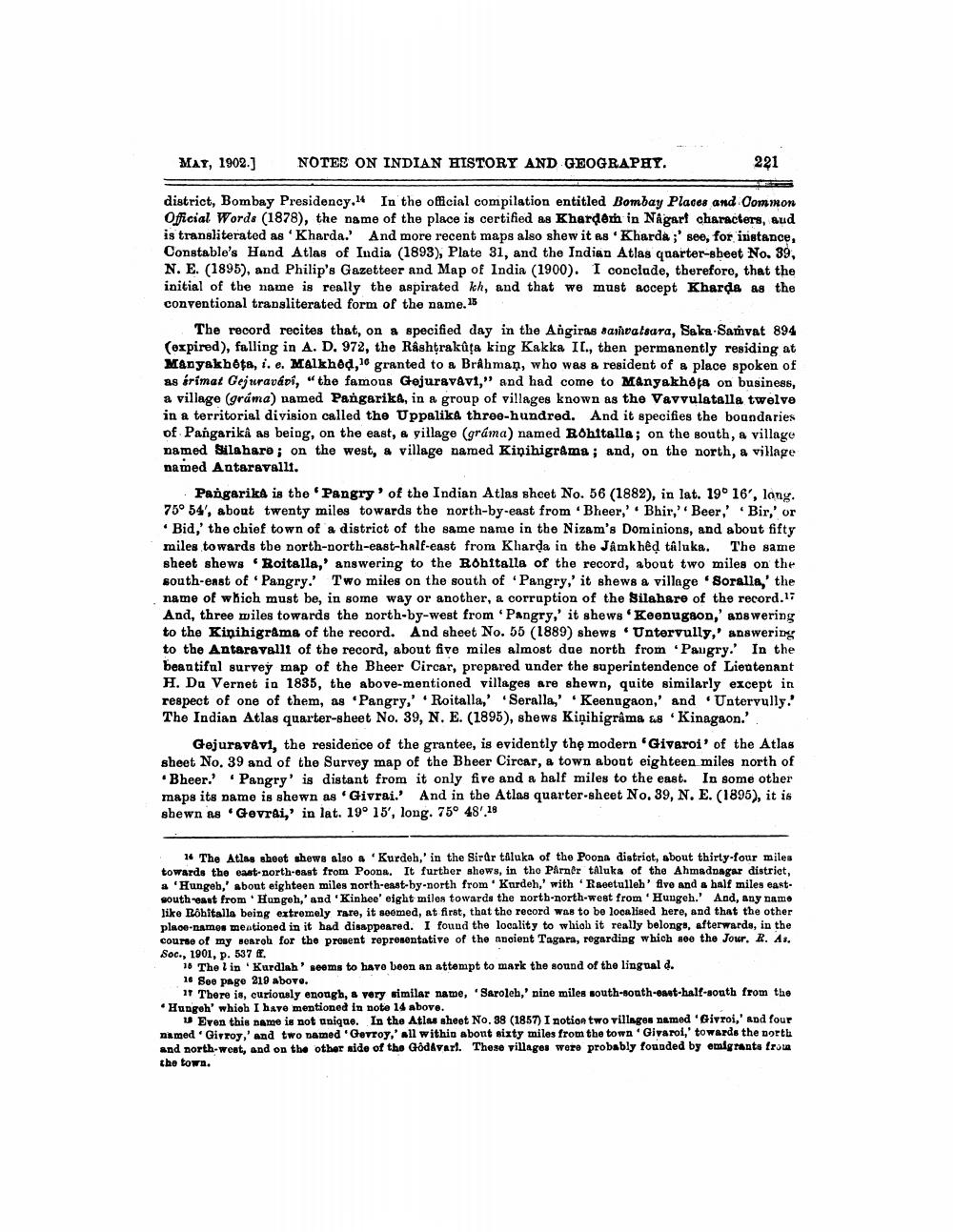________________
MAY, 1902.1
NOTES ON INDIAN HISTORY AND GEOGRAPHY
221
district, Bombay Presidency. In the official compilation entitled Bombay Places and Common Official Words (1878), the name of the place is certified as Khardem in Nagart characters, aud is transliterated as 'Kharda.' And more recent maps also shew it as Kharda ;' see, for instance, Constable's Hand Atlas of India (1893), Plate 31, and the Indian Atlas quarter-ebeet No. 39, N. E. (1895), and Philip's Gazetteer and Map of India (1900). I conclude, therefore, that the initial of the name is really the aspirated kh, and that we must accept Kharda as the conventional transliterated form of the name.16
The record recites that, on a specified day in the Angiras sarīvatsara, Saka Samvat 894 (expired), falling in A. D. 972, the Rashtrakûța king Kakka II., then permanently residing at Manyakbóta, i.e. Malkhod, granted to a Brahman, who was a resident of a place spoken of as érimat Gejuravádí, "the famous Gejuravavi," and had come to Minyakheta on business, a village (gráma) named Pangarika, in a group of villages known as the Vavvulatalla twelve in a territorial division called the Uppalika three-hundred. And it specifies the boundaries of Pangarikâ as being, on the east, a village (gráma) named Rohitalla; on the south, a village named Silahare ; on the west, a village named Kiņihigrama; and, on the north, a village named Antaravalli.
· Pangarika is the 'Pangry of the Indian Atlas sheet No. 56 (1882), in lat. 19° 16', long. 75° 54', about twenty miles towards the north-by-east from Bheer,' Bhir,' Beer,' 'Bir,' or • Bid,' the chief town of a district of the same name in the Nizam's Dominions, and about fifty miles towards the north-north-east-half-east from Kharda in the Jamkhed taluka. The same sheet shews Roitalla,' answering to the Rohitalla of the record, about two miles on the south-enst of Pangry.' Two miles on the south of Pangry,' it shews a village Soralla,' the name of which must be, in some way or another, a corruption of the Silahare of the record. 17 And, three miles towards the north-by-west from Pangry,' it shews Keenugaon,' answering to the Kinihigrama of the record. And sheet No. 55 (1889) shews Untervully,' answering to the Antara vallt of the record, about five miles almost due north from 'Paugry. In the beautiful survey map of the Bheer Circar, prepared under the superintendence of Lieutenant H. Da Vernet in 1835, the above-mentioned villages are shewn, quite similarly except in respect of one of them, as Pangry,' Roitalla,' Seralla,' 'Keenugaon,' and Untervully.' The Indian Atlas quarter-sheet No. 39, N. E. (1895), shews Kiņihigrama Es Kinagaon.'
Gejuravåvi, the residence of the grantee, is evidently the modern 'Givaroi' of the Atlas sheet No. 39 and of the Survey map of the Bheer Circar, a town about eighteen miles north of • Bheer.' Pangry' is distant from it only five and a half miles to the east. In some other maps its name is shown as Givrai.' And in the Atlas quarter-sheet No. 39, N. E. (1895), it is shewn as 'Govrai,' in lat. 19° 15', long. 75° 48'.18
14 The Atlas sheet shews also a Kurdeh,' in the Sirar tåluka of the Poona district, about thirty-four miles towards the east-north-east from Poona. It further shows, in the Pirner Aluka of the Ahmadnagar district, a 'Hungeb,' about eighteen miles north-east-by-north from 'Kurdeh,' with 'Raeetulleh' five and a half miles eastsouth-east from Hungoh,' and 'Kinhee' eight miles towards the north-north-west from 'Hungeh.' And, any namo like Bohitalls being extremely rare, it seemed, at first, that the record was to be localised here, and that the other place-namos mentioned in it had disappeared. I found the locality to which it really belongs, afterwards, in the course of my hearoh for the present representative of the nncient Tagara, regarding which see the Jour. R. As. Soc., 1901, p. 537 .
16 The l in 'Kurdlab seems to have been an attempt to mark the sound of the lingual d. 16 See page 219 above.
It There is, curiously enough, a very similar name, Saroleh,' nine miles south-south-east-half-south from the • Hungeh' which I have mentioned in note 14 above.
1 Even this name is not unique. In the Atlas sheet No. 38 (1857) I notion two villages named 'Givroi,' and four named Girroy,' and two named 'Gevroy,' all within abont sixty miles from the town 'Givaroi,' towards the northa and north-west, and on the other side of the Godavarl. These villages were probably founded by emigrants from the town.




